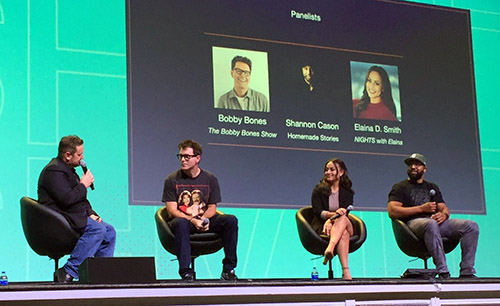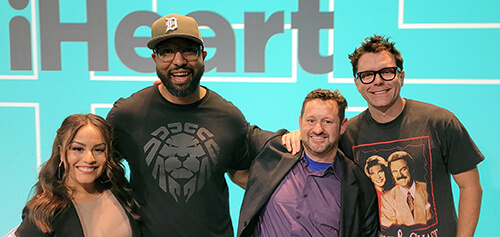What It’s Like to Return to an In-Person Conference


Seth Resler
By: Seth Resler
Jacobs Media Strategies
In the not-too-distant past, I used to travel to industry conferences frequently. I was boarding a plane twice a month to speak at conferences held by trade magazines and state broadcaster organizations.
Then the pandemic hit.
Travel slowed to a crawl as conferences were canceled or converted into virtual events. A few invitations to speak continued to trickle in, though I declined them out of an abundance of caution.
Podcast Movement 2021 was the first invitation to speak that came along after I received the vaccine. At the time I accepted, the country was permeated by an optimistic sense that the worst of the pandemic was over. That sense eroded in recent weeks, but Podcast Movement is one of my favorite events, so I made the trek to Nashville for my first in-person speaking gig since the pandemic began.
For those of you who are headed to an industry conference soon — or maybe just contemplating it — here’s what it was like:
1. In-person attendance was light but virtual attendance was heavy.
There’s no question, Podcast Movement — the world’s largest podcasting conference — had fewer in-person attendees than in the past. This is due in part to the fact that they offered an option to attend virtually, and invested significant resources into optimizing that online experience. The organizers reported about 2,000 in-person attendees and 1,000 virtual attendees, which puts the combined total on par for in-person attendance in past years.
The registration lines were never congested, and prior to the pandemic, a high-profile keynote speaker such as Mark Cuban would have been a standing-room only affair, but this year it was easy to space yourself apart from others with empty seats.
Key players were absent. International regulars like James Cridland and Matt Cundill were present in the Twitter threads even if they couldn’t be there in person. I noticed the absence of some domestic stalwarts as well. I inferred that some of them had children who are too young to get vaccinated, but over the course of the conference I realized that this was just a guess. One of the things you recognize quickly in this environment is that other people can have any number of motives for their actions, and that your assumptions about those motives probably say more about you than they do about others. After a while, you give up on guessing.
Word around the conference was that a handful of companies had canceled at the last minute. I purposely tried to book my session with people who live in Nashville, and sure enough, my one out-of-state panelist canceled just days before the event. While scrambling in this situation isn’t fun, it feels unreasonable to be upset about it. These are strange times; it’s hard to fault anybody for acting with an abundance of caution. Fortunately, champion storyteller Shannon Cason was able to step up and fill the speaking slot, so it all worked out.
2. There was no consensus on wearing masks.
There’s no consensus about wearing masks in this country, so it’s not surprising that there was no consensus at the conference, either. In the airport and on the plane ride to the conference, masks were in full effect; but once I was on the ground in Nashville, it was a different story. Before arriving, I wondered whether many guests at the Gaylord Opryland would be donning masks, but I was particularly surprised to find that very few staff members were wearing masks. This runs counter to my experience in metro Detroit, where it seems as though most employees at stores and restaurants are wearing masks even if customers are not. I chalked this up to regional differences.
Podcast Movement provided color-coded buttons to allow its attendees to indicate how they felt about social interaction — a red button signaled that you were strict about social distancing while a green button was an invitation for hugs. It was a well-meaning gesture on behalf of the organizers, though if the attendees were making use of these, I didn’t notice it.
Most people at the conference walked around without masks. I found it impossible to infer the meaning behind this: Were they vaccinated? Were they making political statements? Were they making some other calculation? I suspect the answer is “all of the above,” and quickly stopped trying to parse people’s motives.
While I masked up as much as possible, the reality is that it was difficult in a noisy environment where you are constantly talking to strangers. I found myself putting my mask on during long stretches of silence, such as when I was watching a session, but removing it (in a socially awkward maneuver that I still haven’t mastered) when talking to somebody. If I didn’t, people often had a hard time understanding me.


Opening Keynote Speaker Tom Webster
Another part of the equation is the physical setup of the Gaylord Opryland, which houses a small jungle under a large glass dome. It’s a stunningly beautiful location which made me feel like Link wandering through Hyrule. Generally speaking, I am much more careful about wearing a mask when I am indoors than I am when I am outdoors. So what do you do when the outdoors are indoors?
I also found myself envious of people who had invested in stylish masks. The Libsyn team, for example, came equipped with branded black masks that looked slick. Meanwhile, I’m still wandering around in a mask that was obviously purchased in bulk from Home Depot. After more than a year of life with COVID, it might be time for me to up my game.
For me, the biggest takeaway is what you think you’re going to do in a situation and what you actually do are not the same; it’s all situational, and the situation keeps changing.
3. You’re speaking to two audiences.
As a speaker, I am used to addressing the people in the room. As a radio broadcaster, I am used to addressing people who are not in the room. But I’ve never had to do both at the same time.
Frankly, I forgot about the virtual audience until I opened up the Podcast Movement mobile app the day after my session and scrolled through the transcript of the live chat that happened while I was on stage. While most people seemed to enjoy the session, a few did complain that they could not hear audience members when they asked questions. This was my fault. I did not expect my panelists to interact with the audience so much; if I had, I would have either repeated the questions into my mic or requested a microphone runner so people watching the presentation online could hear. Moving forward, it’s clear that as a speaker, I will need to give as much thought to the virtual attendees as the in-person attendees.


(L-R) Seth Resler, Bobby Bones, Elaina D. Smith, Shannon Cason
4. There are elephants in the room.
The vast majority of people who read this blog are broadcasters who avoid politics on their airwaves for fear of alienating portions of their audience. And we all know that this has become an increasingly difficult needle to thread in recent years as politics has permeated every aspect of ordinary life.
I believe that one of the reasons America has become so divided is that it’s easier to offend and be offended by other people when you aren’t standing right next to them. This was already a growing problem with the rise of online interaction; the decrease in in-person interaction due to the pandemic has only exacerbated the situation.
When you get a diverse group of people from different regions and with different beliefs together under one room, it can heal some of these divisions. Of course, this happens because there are certain topics of conversation that we avoid due to social niceties. This is both refreshing and jarring.
The cognitive dissonance between the optimism on the conference floor and the bleak prognostications on the cable news channels in my hotel room was hard to ignore. For a conference taking place during a multi-year global health crisis, I heard little mention of COVID-19 aside from comedian Maz Jobrani’s observation that his keynote session was being held in the Delta ballroom. Perhaps that’s because everybody’s tired of talking about it, or perhaps it’s because “So, how’s your pandemic going?” is an awkward conversation opener. Either way, there are things that we’re all thinking about that we’re not all talking about.
5. I miss these people.
I miss these events. I miss them because I miss seeing acquaintances. I have kept in touch with my friends during the pandemic. But I have lost touch with the people that I don’t know that well — the sort of people that I only see at conferences like these. I saw so many people at this conference who are not part of my inner circle, but have been a regular if infrequent part of my life over the past few years, and it was… nice.


(L-R) Elaina D. Smith, Shannon Cason, Seth Resler, Bobby Bones
So many jobs have become difficult during the pandemic, but one of the most challenging is that of event producers. If your livelihood depends on in-person gatherings, it’s become an incredibly difficult road to navigate. This is particularly true with large events that take months to prepare. I have no idea what’s in store for the other conferences that are coming up, from the Radio Show to CES. If we’re being really honest, I am glad that I am not the one who has to figure it out. But congratulations to Dan Franks and Jared Easley who produced a successful show under trying circumstances. Special thanks to Julie Leithoff who is always a pleasure to work with, and to my panelists — Shannon Cason, Elaina D. Smith, and the newly married Bobby Bones.
I hope to see you all at Podcast Movement next year in Dallas! Now, please excuse me while I check to see if my COVID test results are in.
For more assistance on digital or social media, contact MAB Member Services at mab@michmab.com or 1-800-968-7622.
Editor’s Note: The views and opinions of this article do not necessarily reflect those of the MAB. Contact the MAB for information on the MAB’s official editorial policy.
